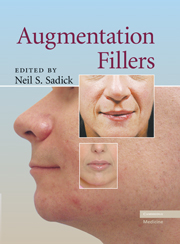Book contents
- Frontmatter
- Contents
- LIST OF CONTRIBUTORS
- Ch. 1 Application of Fillers
- Ch. 2 Approach to Choosing the Ideal Filler
- Ch. 3 Patient Selection, Counseling, and Informed Consent
- Ch. 4 Hyaluronic Acid Skin Derivatives
- Ch. 5 Collagen Products
- Ch. 6 Radiesse
- Ch. 7 ArteFill
- Ch. 8 Augmentation Fillers in Cosmetic Dermatology: Silicone
- Ch. 9 Advanta Expanded Polytetrafluoroethylene Implants
- Ch. 10 Sculptra
- Ch. 11 Lipo Transfer
- Ch. 12 BioAlcamid®
- Ch. 13 Combination of Approaches in Augmentation Fillers in Cosmetic Dermatology
- Ch. 14 Filling Complications
- Ch. 15 Postprocedure Management and Patient Instructions
- Ch. 16 Conclusion: Future Trends in Fillers
- INDEX
- References
Ch. 8 - Augmentation Fillers in Cosmetic Dermatology: Silicone
Published online by Cambridge University Press: 26 February 2010
- Frontmatter
- Contents
- LIST OF CONTRIBUTORS
- Ch. 1 Application of Fillers
- Ch. 2 Approach to Choosing the Ideal Filler
- Ch. 3 Patient Selection, Counseling, and Informed Consent
- Ch. 4 Hyaluronic Acid Skin Derivatives
- Ch. 5 Collagen Products
- Ch. 6 Radiesse
- Ch. 7 ArteFill
- Ch. 8 Augmentation Fillers in Cosmetic Dermatology: Silicone
- Ch. 9 Advanta Expanded Polytetrafluoroethylene Implants
- Ch. 10 Sculptra
- Ch. 11 Lipo Transfer
- Ch. 12 BioAlcamid®
- Ch. 13 Combination of Approaches in Augmentation Fillers in Cosmetic Dermatology
- Ch. 14 Filling Complications
- Ch. 15 Postprocedure Management and Patient Instructions
- Ch. 16 Conclusion: Future Trends in Fillers
- INDEX
- References
Summary
INTRODUCTION
As the armamentarium of fillers for soft tissue augmentation expands, physicians and patients continue to seek those that approach criteria for the “ideal filler.” Regardless of treatment area, the ideal filler would demonstrate versatility, biocompatibility, consistency of results, a natural feel, an excellent safety profile, and a superb cost-to-benefit ratio. Furthermore, it would be easy to inject, have minimal side effects, and not require allergy testing. The ideal filler would also achieve some degree of longevity and, arguably, permanence.
Liquid injectable silicone (LIS) is the original permanent, synthetic soft tissue–augmenting filler that may be employed for a variety of cutaneous and subcutaneous atrophies. Used worldwide for at least forty years, it distinctively meets a majority of the criteria that would define the ideal filler, including versatility, reliability of results, a natural feel, and an excellent cost-to-benefit ratio. When LIS is appropriately administered with the microdroplet serial puncture technique, patients may obtain enduring correction of scars, rhytids, and depressions, as well as lasting augmentation of lips and other facial contour atrophies and deformities.
However, the “permanence” of LIS refers to the enduring nature of the product in vivo rather than a “permanent” cosmetic result. Although the progressive tissue volume loss of aging will continue to occur, the degree of correction due to placement of LIS will persist. For this reason, silicone and other permanent fillers are much less forgiving than temporary fillers, in that overcorrection or undesired augmentation will also persist. Hence, experience and precise technique are prerequisites to favorable patient outcomes.
- Type
- Chapter
- Information
- Augmentation Fillers , pp. 69 - 80Publisher: Cambridge University PressPrint publication year: 2010



